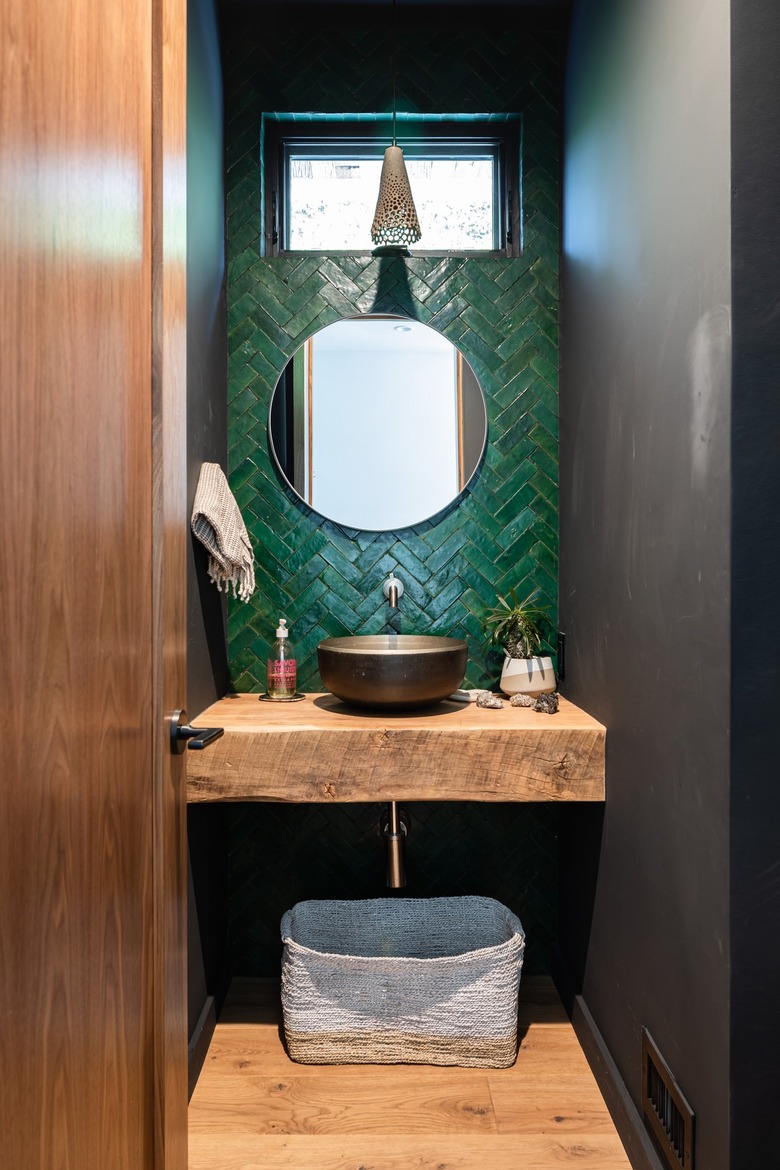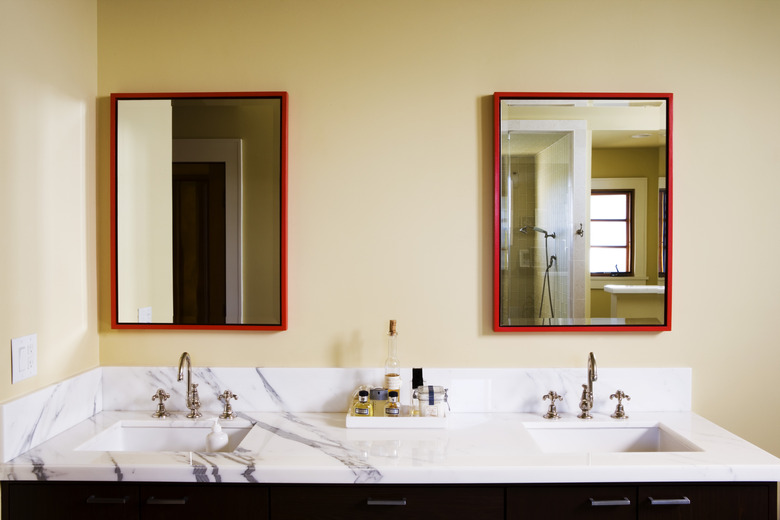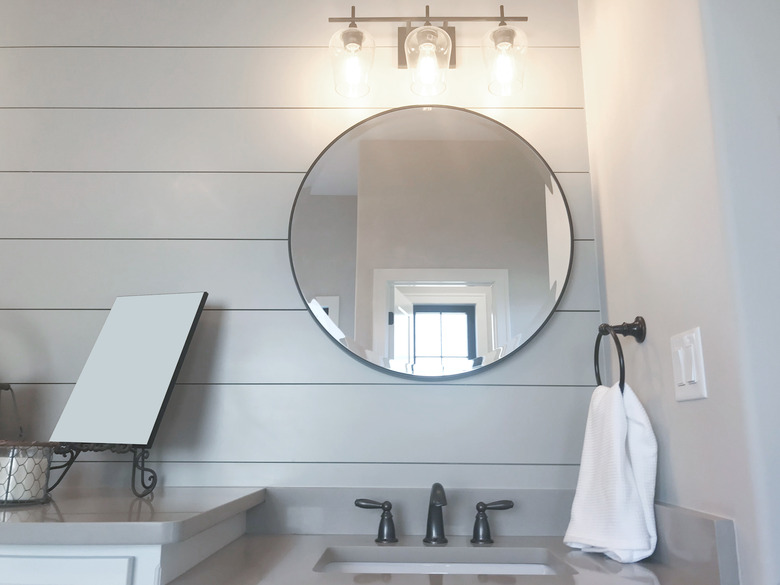How To Remove A Bathroom Mirror
We may receive a commission on purchases made from links.
Depending on how it was installed, removing a bathroom mirror may be a quick and simple process, or it may leave you cursing the person who glued it to the wall. In a best-case scenario, you'll only have to loosen and remove some clips that are holding up the mirror, but in many cases, adhesive is on the back of the mirror, which means a bit of careful prying to loosen the mirror from the wall.
Removing a Mirror: Safety First
Removing a Mirror: Safety First
No matter how the bathroom mirror is attached, a few safety precautions are a must, especially if the mirror is large enough to be heavy, cumbersome or both. Wear eye protection, work gloves, long sleeves, thick shoes and pants while removing the mirror so if it shatters in places and shards fly, they're less likely to cause harm.
To minimize the potential for flying shards, tape the front of the mirror diagonally, horizontally and vertically many times without covering any clips or devices that are holding up the mirror. If you plan to save the wall mirror, use wide masking tape or painters' tape since the adhesive is easy to remove. If you're discarding the mirror, feel free to use duct tape, which has a gummier adhesive. Masking tape or painters' tape is also a good option if you plan to donate the mirror to a place such as a Habitat for Humanity ReStore shop, as they'll be able to remove the tape without leaving a sticky mess on the mirror front.
Clear movable items away from the work area, including anything on the sink and small items that may cause tripping, such as a trash can or a bathroom rug. Place a drop cloth over the sink and vanity and cover any floor vents with a hand towel. This way, nothing goes down the drain or down floor vents, and it's easier to contain any screws or glass shards that may fall.
Removing Bathroom Mirror Clips
Removing Bathroom Mirror Clips
Some mirrors are held in place with small, screwed-in clips on the top, bottom and sides of the mirror. Though simple, the removal method varies a bit from one style to another. Some clip sets have spring-loaded top clips, which allow a little more wiggle room for installing or removing the mirror, according to Reflect Window & Door. To determine if you have this type, grab the sides of the mirror or even the bottom edge if you don't have much room on the sides and gently push upward.
If the top clips have springs, the mirror can be lifted upward enough to lift it out of the bottom clips once the side clips have been removed, and the bottom clips have been loosened a little. Remove the side clips by loosening and removing the screws holding them in place. Enlist a friend or two to help with a large mirror to prevent it from falling during the removal process. Set the mirror temporarily in a safe location, such as on a bed or atop a tablecloth on a large table. Remove the rest of the clips.
Some clips have plastic covers to hide the screws. Remove the cover by prying it off with a flat-head screwdriver inserted into a notch along one of the clip's sides. If you are dealing with a set of clips that aren't spring-loaded, loosen the screws in the side and top clips first, allowing the bottom set of clips to help hold up the mirror until you're ready to completely lift it off the wall. Loosen the bottom set partially so you can wiggle the mirror away from the wall with a friend's help. In some cases, the mirror may have a bit of adhesive on the back as well, which means you'll have to grab a few more tools.
Removing a Glued-On Mirror
Removing a Glued-On Mirror
Removing a bathroom mirror that is glued to the wall involves a bit of extra work; hastily prying it free will result in dangerous breakage and shards of glass flying off in an unpredictable manner. The safest way is to loosen the adhesive with heat from a heat gun; once the glue softens a bit, the mirror is easier to pry from the wall with less chance of breakage.
It's not always possible to prevent breakage, but taping the mirror first and applying heat to the mirror's perimeter helps prevent flying shards of glass. A few wood shims shoved along the top edge and near the top of the side edges provide extra leverage to loosen the mirror as the adhesive softens.
Apply heat to an accessible top corner of the mirror using the lowest setting on your heat gun or a medium to high setting on a hair dryer if a heat gun isn't available. Hold the heat gun 5 or 6 inches off to the side of the mirror, blowing heat between the mirror and wall for 10 seconds or so at a time. Work your way down the side of the mirror. Exercise caution and be sure to wear heavy work gloves, as the front of a heat gun and the surfaces it warms can get incredibly hot in a hurry.
Check your progress every so often by sliding the edge of a thin carpenters' square or long metal ruler diagonally between the mirror and the wall. If the adhesive is warming enough to soften, the tool should be able to push through the adhesive, loosening the mirror a bit more. A thin flat bar (pry bar) can also be used, although extra care must be taken to avoid shattering the glass or damaging the wall. In some cases, such as if there isn't a lot of adhesive on the wall, the mirror may come free from the wall without much trouble. Have a hand or a helper holding the top edge of the mirror in case it starts to drop.
Cutting With Wire
Cutting With Wire
A serrated stainless steel cutting cable comes in handy for slicing through the adhesive once you have enough room to slide a narrow object behind the mirror. If you have a long enough piece of steel cable and room to move it, position one end outside each top corner of the mirror and, with a helper, work it back and forth behind the mirror while pushing downward. Otherwise, start in a corner and work your way diagonally downward with a sawing motion. This helps break the adhesive's bond with less chance of mirror breakage than using forceful leverage, such as a crowbar.
In a pinch, a length of picture wire or a guitar string will also work if you wrap the ends a few times around gloved fingers. Enlist a friend's help to ensure the mirror doesn't fall on its own if you are working the wire on your own. Pay attention to the mirror and be ready for it to fall once its top is several inches from the wall. If a metal tray-style clip holds the bottom edge of the mirror, lift the mirror out of the tray once it is loose.


